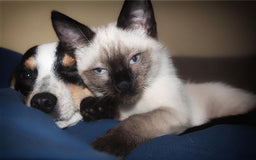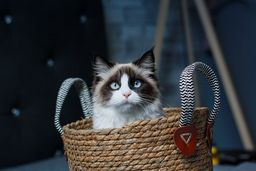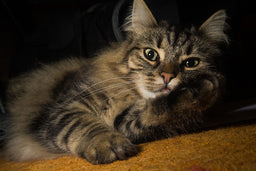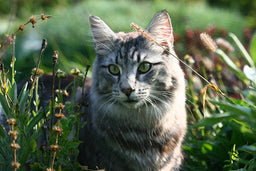A friend for life, but how long do Ragdoll cats live?
As any Ragdoll parent will tell you, having one in your life is a gift of friendship that few other cat breeds can match.
Ragdolls are friendly to the point of clinginess, and most parents want their companionship to last forever.
Special attention to diet, grooming, healthcare, and keeping your Ragdoll occupied are all part of the daily routine, but there will come a point when even the best food and the most expert vet can’t help anymore.
When can you expect that point to be reached? How long do Ragdoll cats live on average? Read on and get the best answers and some advice on how diet, illness prevention, and careful monitoring can keep your Ragdoll happy and healthy for as long as possible.

The beginning of a loooooooong journey!
Source: Pixabay
What life stages do Ragdolls go through?
From birth up to 6–8 weeks, Ragdolls are considered infants and will usually stay with their mother, being gradually weaned at around 4–5 weeks.
From 2 months to the end of their first year, Ragdolls are considered kittens, only reaching full adulthood at 18 months. This is normal for larger breed cats, as both muscles and skeletal structure take longer to form than in more petite breeds, such as Siamese, Burmese, or Somali.
From leaving kittenhood up to the age of 10, Ragdolls are considered adults, after which they progress to the mature or senior stage of their lives.
From that point onwards, the sky’s the limit.
What is the average lifespan of a Ragdoll cat?
Ragdolls have an average lifespan that is slightly higher than many breeds.
Every cat is an individual, so generalisations are likely to be wildly inaccurate, but many Ragdolls can live comfortably past the average cat life expectancy of 13 years, even reaching 20 or older.
The length of a cat’s life depends on:
- Genetic predisposition
- Lifestyle and activity level
- Diet and weight
- Whether the Ragdoll lives indoors
- Regularity of healthcare
- Whether or not the feline is neutered
Genetic predisposition
Your Ragdoll’s DNA is the most important factor in what lifespan can be expected.
If your cat has long-lived ancestors, or if there is a history of hereditary disease in the bloodline, this will affect their life expectancy.
Lifestyle and activity level
The healthier the lifestyle, the longer the life expectancy of a Ragdoll cat.
Cats that lead an active life and don’t fall into sedentary habits stand a better chance of advancing into old age with fewer bouts of illness.
If your Ragdoll is one that follows you around the house all day, getting under your feet and tripping you up regularly, the exercise could be the best thing to ensure a long life.
Diet and weight
Both the quantity and quality of food a Ragdoll eats can affect the average life of a Ragdoll cat.
Ragdolls that eat too much of the wrong kind of food are more likely to contract debilitating age- and lifestyle-related illnesses, such as:
- Diabetes
- Hyperthyroidism
- Urinary tract infections (UTIs), like cystitis or bladder stones
- Digestive disorders
Indoor life
Although activity in the great outdoors is undoubtedly healthy for a Ragdoll, the breed isn’t thought to be particularly street-smart.
Statistically, this means that Ragdolls that spend time outside are more likely to come a cropper through:
- Fighting
- Car accidents
- Natural hazards
Regularity of healthcare
Ragdolls are not particularly sensitive or prone to illness but do require regular health checks.
Their friendly disposition and constant companionship can often lead their parents to feel everything must be alright, as long as the kitty is wandering around the house as normal.
Regular prophylactic check-ups are essential and can allow any illnesses to be caught early enough for effective treatment.
Neutering your pet
Neutered Ragdolls seem to be hardier and less susceptible to health niggles.
This may be anecdotal, but they are also reputed to be able to better resist contagious diseases.
This is possibly linked to the fact that altered felines are more likely to stay at home instead of prowling their manor looking for trouble.

Best place for a Ragdoll is safe and warm at home.
Source: Pixabay
What illnesses do Ragdolls suffer from?
Ragdolls are generally considered fairly resilient, but several health conditions are common in the breed, namely:
- Dental issues
- Respiratory conditions
- Heart weakness
- Kidney problems
- Digestive issues
Dental issues
Like many cat breeds, Ragdolls can suffer from gum disease, leading to tooth loss in later years.
While losing a few teeth is not normally a major issue, your Ragdoll may find eating painful, particularly if you are feeding kibbles. This can lead to a short-term reluctance to eat that can be harmful, particularly in older Ragdolls.
Good dental hygiene through a regular teeth-cleaning regimen can help avoid major dental problems, and oral health should be checked periodically by your vet.
Respiratory conditions
Ragdolls can suffer from occasional sniffles (cat flu) and even feline asthma.
You can vaccinate against the most common flu viruses, but asthmatic conditions may require long-term medication to be prescribed by your vet. These can be in tablet, injection, or inhaler form.
You should also avoid diffusers or air fresheners in your house—essential oils like peppermint oil can cause severe allergic reactions in your Ragdoll.
Heart weakness
Ragdolls can suffer from genetic heart disorders and lifestyle-related conditions, such as feline hypertrophic cardiomyopathy, which can lead to heart failure.
Most Ragdoll breeders will screen for congenital weaknesses, but you can help avoid cardiomyopathy developing by managing your Ragdoll’s weight and exercise regime.
Weight management is best achieved through:
- A healthy diet—Avoiding food rich in carbs and unhealthy snacks, such as crisps, nuts, bananas, or cake, is crucial to keeping your Ragdoll lithe and trim
- Adequate exercise—Even though most Ragdolls avoid going outside, you should ensure your feline plays, runs around, and gets energetic regularly. With Ragdolls, this is usually easily achieved, as they are renowned for their boisterous play habits
Kidney problems
While kidney issues are not specific to the Ragdoll breed, they can occur as a result of:
- Habitually drinking too little (cats have a low thirst reflex)
- Licking something toxic, such as antifreeze
- Tumours and UTIs
Kidney damage is irreversible but can be managed with medication and a strictly controlled diet.
Digestive issues
The Ragdoll breed is known to be susceptible to digestive problems, including:
These can cause acute weight loss, with possible knock-on effects on the liver and kidneys.
Chronic bowel problems can also lead to difficulty absorbing nutrients in later life.

Great food and an exciting lifestyle with lots of play is the key!
Source: Pixabay
What can you do to maximise the life expectancy of Ragdoll cats?
All of the above-mentioned conditions in Ragdolls can affect how long your cat will live, but most are either preventable or manageable—your role as a cat parent is to:
- Offer the best possible food
- Ensure your Ragdoll gets enough exercise
- Have your feline regularly checked by your vet
The most important thing you can do to keep your Ragdoll healthy and happy for as long as possible is to provide the best possible food.
Ragdolls are famously finicky but respond well to food that is based on a cat’s natural diet, meaning that it should be made up of:
Animal protein
Ragdolls need meat to get all the amino acids—like taurine—required for:
- Energy
- Strong muscles
- Healthy skin and coat
- Well-maintained organ function
Plant-based protein simply doesn’t cut it with cats—they have evolved to process meat considerably more efficiently and need much less meat-based food to satisfy their nutritional needs.
You can see this by looking at the biological value (BV) of the common protein sources used in commercial cat food. The BV measures the efficiency with which cats can metabolise each protein, and the most frequently seen cat food ingredients score is as follows:
|
Protein type |
BV |
|
Animal protein, including: |
88%–98% |
|
Vegetable protein, such as: |
45%–68% |
Providing Ragdolls with food that contains at least 50% animal protein will help keep them healthy and energetic throughout their lives.
Animal fat
Animal fat—such as that found in high-quality cat jelly or cat gravy—is a great secondary energy source and delivers essential fatty acids, such as:
- Linoleic acid
- Arachidonic acid
- Omega-3 and omega-6 acids
Another benefit of animal fat is that cats love its taste and smell.
Even fussy Ragdolls go wild for food rich in animal fat, so you should have no problem providing healthy nutrition that gets wolfed down.
The right vitamins and minerals
Your Ragdoll needs a broad spectrum of vitamins and minerals to regulate bodily processes.
These are all found in sufficient quantities in meat, with liver being an excellent source of both.
No carbs, grains, or cereals
Cats don’t handle carbs, grains, or cereals well.
While carbohydrates can be an excellent source of fast-release energy, any unburnt calories they deliver end up being stored as fatty cells.
Carbs are the number one cause of obesity in cats, so they should be avoided if you want your Ragdoll to enjoy a long and active life.
Whatever type of food you opt for—be it wet, semi-moist, dry, raw, or homemade—choosing the highest-quality, meat-based diet is the right thing to do to maximise your Ragdoll cat’s lifespan and quality of life.
How can Untamed help improve Ragdoll cat life expectancy?
Untamed can’t change nature, but we are the best way to keep your Ragdoll healthy and happy for as long as possible.
Untamed cat food is the non-plus-ultra when it comes to nutritional goodness for your Ragdoll. Every Untamed tin features:
- Exclusively animal protein
- Vet-formulated recipes
Exclusively animal protein
Every tin of Untamed—whether it’s Chocka Chicken, Tuck-In Tuna, or Full-On Fishy—contains more than twice the amount of animal protein you find in most commercial cat foods.
Your Ragdoll will go wild about the taste of Untamed, and even cats that normally avoid wet food are said to find our products irresistible.
Vet-formulated recipes
All our Untamed recipes have been formulated by vets to ensure your Ragdoll gets all the right nutrients.
This means that our products are all free from known allergens, easily digestible, and suitable for every stage in your Ragdoll’s—hopefully long—life.
Untamed also believes that a long life should be spent on a healthy planet.
To this end, we are committed to:
- Only sourcing from sustainable, cruelty-free suppliers
- Guaranteeing our packing is 100% recyclable
- Running our entire supply chain on a carbon-neutral basis
Want to keep your Ragdoll healthy for a long, fruitful life? Try Untamed and do the right thing for your feline friend!

Untamed has all the ingredients for a long, happy life!
Image (c) Untamed
Get Untamed now for your young or old Ragdoll cat!
Starting out with Untamed can’t happen too soon for your Ragdoll!
We’ve made the process of giving health and vitality to your Ragdoll really easy with our monthly cat food subscription—all you have to do is order online:
- Give us some details about your Ragdoll
- Pick a meal plan for your kitty
- Order your initial trial pack
Once your trial pack arrives, you and your Ragdoll can look forward to a lifetime of great-tasting, healthy food. We’ll keep you stocked up so you never need to worry about where the next meal is coming from.
Ragdoll parents who have made the leap to Untamed’s world of goodness tell us you can expect the following results:
|
Timeline |
What Untamed can do |
|
In a week |
|
|
Within 2 months |
|
|
After 4 months |
|
|
For life |
|



